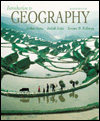 |  Introduction to Geography, 8/e Arthur Getis,
San Diego State University
Judith Getis
Jerome D. Fellmann,
University of Illinois, Urbana-Champaign
Maps
Objectives:After reading and studying this chapter you should be able to:
1.
Differentiate between latitude and longitude and locate any place on the globe if given its latitudinal and
longitudinal coordinates.
|
 |  |  | 2.
Determine the time and day at any point on the earth if given the time at any other point and number of time
zones between them.
|
 |  |  | 3.
Understand the theory behind map projections. Differentiate between geometric projections (cylindrical, conic and planar) and those projections derived from mathematical formulae.
|
 |  |  | 4.
Understand the properties of maps and how they are distorted by map projections.
|
 |  |  | 5.
Determine which projection is most suitable for which types of maps.
|
 |  |  | 6.
Understand scale as a means of representing portions of the earth's surface on a flat map. Differentiate
between a large scale and small scale map.
|
 |  |  | 7.
Read and interpret map patterns and symbols, including those on a topographic map.
|
 |  |  | 8.
Distinguish among the various forms of remote sensing and know their purposes.
|
 |  |  | 9.
Enumerate the advantages of computer assisted cartography and geographic information systems as means
of analyzing and presenting data.
|
|



 2002 McGraw-Hill Higher Education
2002 McGraw-Hill Higher Education